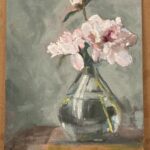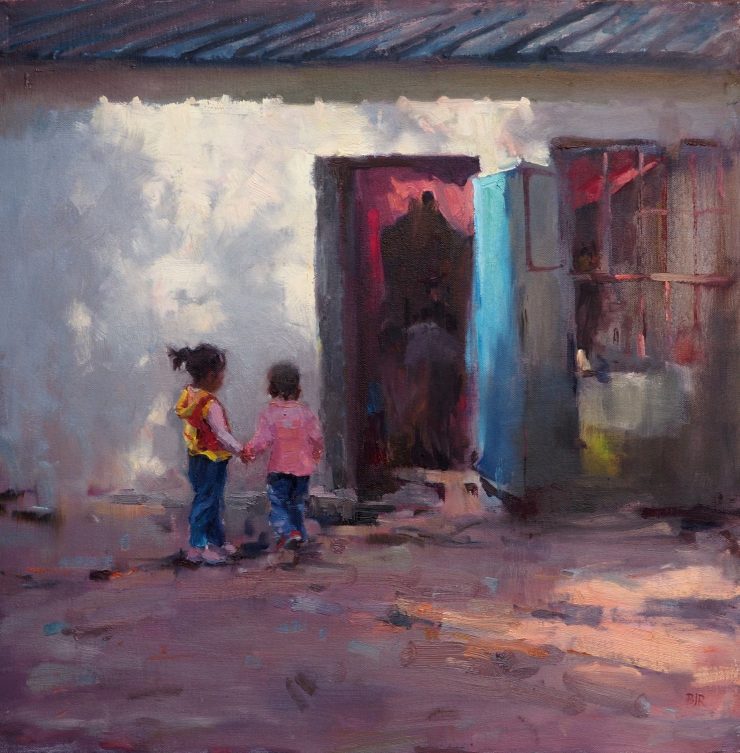Table of Contents
Toggle(Get free painting tips and plein air painting techniques sent straight to your inbox or on my social media.)
Many students ask if direct sunlight damages oil paintings, or if they can put their oil paintings out in the sun to make them dry more quickly. Whilst you can do this, there are good reasons to avoid it.
Damage to oil paintings from exposure to sunlight or a heat source
Putting the painting in a position where it gets hot for an extended period of time will ultimately damage the oil painting. Also oil paintings are damaged by exposure to ultraviolet radiation. When oil paint is heated a chemical reaction takes place that alters the oil paint. This results in a change in the colors which can be visible to the viewer.
The discoloration and deterioration typically occurs at the surface of the oil painting after prolonged exposure to heat, for example from a sunlit window, or exposure to other sources of heat such as being placed near to a fire or fireplace. There is additional damage due to ultraviolet radiation if you place the painting where it gets direct sunlight.
However, it does take some time for the damage to occur, so for a short time it may not be too serious a problem. Most oil paintings will not suffer much damage over a short time. There is more of a problem if there is some exposed canvas in the painting. These is because sunlight can damage canvas, but it will not damage the canvas through the oil paint.)
A note on watercolors in sunlight
You should not place watercolors in direct sunlight. They will fade very quickly. The same goes for works on paper and photography, as even most indirect light can cause fading. The painting will fade even if the painting has a frame made of UV plexi glass, since the plexi glass does not prevent all sun damage.
What affects the drying time of oil paints
The drying time of oil paints depends on these factors:
- temperature – the warmer the temperature the faster the drying time.
- pigment – different pigments dry at different speeds. Cadmiums dry extremely slowly. Earth pigments dry extremely quickly.
- medium – each medium you use to mix with the paint will affect the drying time in a different way.
How To Make Your Oil Paintings Dry Quickly
Here are some ways to help your oil paintings dry quickly. You might want to use these methods for when you are traveling for example.
- Use alkyd white instead of normal white to mix with your oil paints. This will make your paintings dry in a day or two, compared to a week. You might have some problems with yellows where you have not added white unless it is a quick drying yellow. Generally Cadmium Yellows PY35 (based chemically on Cadmium Zinc Sulphide) dry slowly but the less expensive and commonly used Hansa Yellows PY1, PY2, PY3, PY6, PY9 (based chemically on monoaso, arylamide) dry quickly.
- Use an alkyd medium with your colors. I typically find this is not such a good method as the paint dries too quickly during the painting session.
Glazing with fast drying mediums
If you are glazing an oil painting you can use a medium such as Winsor & Newtons Liquin to make the glaze dry quicker.
Caution
You should not use this method on top of an impasto oil painting as it is unlikely the underlying paint is fully dry. In general you want to put slower drying layers on top of faster drying layers. If you put a fast drying layer on top of a slow drying layer, your oil painting is likely to crack.
Fat Over Lean Rule
If you paint an oil painting using different layers, each successive layer needs to be more flexible than the one underneath. To do this, add more medium to each successive layer. This makes each new layer more flexible than the previous one and prevents the painting from cracking. Another way of expressing this rule is ‘Flexible over Non-Flexible.’
Thick Over Thin Rule
If you like to paint using impasto paint (or thick paint), it is best to place the thick brushstrokes over thinner layers of paint. The reason for this is because the thin layers dry more quickly. So if you want to build up the surface of your painting using an impasto impressionist style, then avoid putting thinner layers on top of your thick impasto paint. If you do that you painting is likely to crack.
You can get around this limitation somewhat by applying the fat over lean rule. If you add more oil to the upper thin layer, it will slow the drying down and lower the chance of it cracking.
Slow Drying Over Fast Drying Rule
Use fast drying colors in your under layers. If you paint a fast drying layer on top of a slow drying layer then your painting may crack. This is because the fast drying layers will have dried on top of layers that are still in the process of drying out. When paint dries it moves, so if the topmost layer is already stiff, this movement in the lower layers will crack it.
You can similarly get around this limitation by applying the fat over lean rule. If you add more oil to fast drying paint, it will slow down the drying time and lower the chance of it cracking.
References
- Physical Properties of Modern Artists’ Oil Paints. Recent CMOP progress at the Getty Conservation Institute and CATS
- New tools for managing daylight exposure of works of art: case study of Hambletonian, Mount Stewart, Northern Ireland
Thank You
Thank you for taking the time to read this article. I hope you find it useful. If you would like to get free painting tips by email, please sign up for my free tips newsletter.
If you are interested in a structured approach for learning how to paint, take a look at my online painting classes.
Happy painting!
Barry John Raybould
Virtual Art Academy
What The Students Are Saying
The equivalent of a 4 year art education at a fraction of the cost

Read more “The equivalent of a 4 year art education at a fraction of the cost”
The most comprehensive art instruction I could find anywhere online, and trust me, I had been looking for a long time.

The Virtual Art Academy is simply the most comprehensive art instruction I could find anywhere online, and trust me, I had been looking for a long time.
Even art schools and academies I’ve been exposed to are nowhere near as thorough, VAA is just amazing!
Most paintings I see where the artist clearly has some skill still lack in either the values or notan department, or fall down on composition – it’s baffling that VAA seems to be the only program that goes into detail on this. Therefore, if you are new to painting or an experienced artist, studying with VAA will get you to that next step.
I also find that Barry is always interested in what we students do and is at hand with great advice. Worth every penny, Thank you Barry!!
Barry gave me a fishing rod so I can catch my own fish

Read more “Barry gave me a fishing rod so I can catch my own fish”
‘Ladder of Learning’ adds to overall positive experience of this awesome course

Read more “‘Ladder of Learning’ adds to overall positive experience of this awesome course”
It is a real course that trains you in a structured way

Read more “It is a real course that trains you in a structured way”
The course is for beginners, intermediate and advanced artists

Read more “The course is for beginners, intermediate and advanced artists”
Fantastic lesson plans, and a vibrant community
The Virtual Art Academy is the perfect art course I’ve been searching for. Barry’s decades of knowledge are condensed into fantastic lesson plans, creating a vibrant community. The apprentice course delves deep into drawing, painting planning, and color theory. It’s like obtaining an art degree at my own pace and more affordably. The structured format encourages interaction and feedback, enhancing the learning experience. Overall, a fulfilling way to study art from home.
Since I started the programme I can see improvements in my composition and use of colour

I have been working through the VAA course for over five years and would highly recommend it to anyone wanting to improve their painting. There is a huge amount of information on the site and it is well presented and regularly updated and added to. When other members have commented on work I have posted I have found it really useful. When I review my work over the time since I started the programme I can see improvements in my composition and use of colour.
Read more “Since I started the programme I can see improvements in my composition and use of colour”
A great learning platform

VAA, the ultimate art course

Only online learning program I have ever discovered using a training industry best practice

VAA is the only online learning program I have ever discovered using a training industry best practice of incorporating Knowledge and Skills to support learning a new activity. Every building block (Drawing, Form, Observation, Concept, Notan, Composition, Colour, Brushwork) incorporates a “spiral learning” approach where you are introduced to the Knowledge/Skill at one level and then reintroduced to it again elsewhere in the curriculum. Sure genius.
I’ve attended workshops, read books, and watched YouTube videos — and none of them provide the scaffolded approach to learning the VAA offers. If you are just starting your painting journey, start here. If you are a mid level or advanced painter, start here. There is a sense of community with artists around the globe. You are part of a peer to peer learning process bigger than yourself.
As a result of the VAA, I have been juried into several shows, am represented by a local gallery and have been selling my paintings on a consistent basis. VAA curriculum’s approach will grow your ‘artist’s brush’ and aid you in finding your artistic voice. As your basics improve, your art improves. Henry Hensche said, “There is study and there is performance, and we should not confuse the two, study is done for perceptual development, our performances show us where we are in that development, and we must have both…”. VAA curriculum offers both.
I went through the entire curriculum, did every every exercise, and today review my printed books/exercises on an annual basis to keep myself fresh and ready for my next painting adventure.
Onwards/Sideways,
Jay “jbird” Holobach
https://www.jayholobach.com/
I’m Richard Robinson …. best online art training available on the internet today

In my opinion Barry has created the best online art training available. I found the Virtual Art Academy course of painting lessons many years ago and was so inspired by it that I contacted the author and got to know him personally.
Two Critical Keys
If you are looking (like I did) for the best painting course available there are two key things you should know about the Virtual Art Academy course which make it stand out above the other online painting courses available today:
1. It’s Comprehensive.
It covers ALL the key painting concepts and then goes further, revealing more and more painting insights. Most courses miss a LOT out – this one doesn’t.
2. It’s easy to understand.
All that information could easily become confusing, but each piece is laid out clearly and concisely using Information Mapping® making it a pleasure to learn.
If you can find another painting course which does these 2 things better, please let me know. As I said, I have been searching for many years and continue to do so, so you could save yourself a lot of precious time and money by joining the Virtual Art Academy today.
Read more “I’m Richard Robinson …. best online art training available on the internet today”
Building blocks of learning is the best I have seen

Read more “Building blocks of learning is the best I have seen”
First quality education, materials, layered learning systems, feedback loop and social support and lifelong learning – amazing
Thank you again for such an amazing program and opportunity. I wish you continued and even greater success. You have contributed to many many people… thank you from all of us.
An excellent foundation on so many aspects of painting

When I got word of the course available through Virtual Art Academy, I was very excited for the opportunity to learn what I never knew about painting. VAA has provided me an excellent foundation on so many aspects of painting. The course is organized very logically, provides great examples, diagrams, thorough explanations and worthwhile assignments. I highly recommend this course to anyone with a desire for an in-depth education of art.
Thank you again, Barry, I love this course Jeanne
Read more “An excellent foundation on so many aspects of painting”
What I learned from 10 years with VAA

It does mean you have to look at things differently in the beginning but it is really exciting to learn a new, simpler way of painting- its all about VALUES!!!
It all seems a bit strange, making Notans, outline studies, value studies all in greys, colour maps, ie not painting a pretty picture in colour, but you must trust the experts and just do it. It’s all about being able to see the big shapes and values which takes, in my case, a long time for the brain to learn how to do. Once you see, it the lightbulb goes on and everything clicks into place.
Be patient, do the exercises, trust the process and you will get good results. I did as Barry suggested and just worked through the exercises in my sketchbook from life, I didn’t paint pictures for long time. I stayed on values studies for a very long time and found I was enjoying painting again.
It’s ok to take your time. Just keep working and try to find a routine for studying, keep at it. After a long time working like this I am now getting pictures into Art Societies in London (The Chelsea Art Society and the The Mall Galleries- RBA, NEAC and Pastel Society) selling them and even winning prizes. I’ve joined Plein Air groups in London and Surrey (which are free) met and made new friends and am part of a community of like-minded artists which is important to me and makes me happy.
Georgie Rey
https://www.artmajeur.com/georgina-rey
It is impossible to fail or gain little through extensive 4 year study at VAA!

Read more “It is impossible to fail or gain little through extensive 4 year study at VAA!”
The improvement in my own work reaffirms that I’ve found the right program to develop as an artist

The small steps are easy to do

This is a far more superior school than anything I have seen being taught at colleges across the country

No need to buy expensive art books…. Just do the VAA 4 year course. I still refer to it

Read more “No need to buy expensive art books…. Just do the VAA 4 year course. I still refer to it”
I started learning oil painting with VAA from scratch. Just one year later my paintings started to sell

The most comprehensive, in depth and well-organized painting course available online

Read more “The most comprehensive, in depth and well-organized painting course available online”
The sky’s the limit

comprehensive art education

The course has a steady learning curve that keeps revealing itself as you advance

Read more “The course has a steady learning curve that keeps revealing itself as you advance”
It is wild to see how much I am learning in this course!

I retired last year, and decided I wanted to spend my time in retirement learning how to oil paint. But having never painted before, I wasn’t even sure what to look for in an online painting course. However, I did some searches for “Best Online Oil Painting Courses,” and found several references to VAA.
I signed up for VAA’s ongoing Apprentice Program last October (2023), and I am incredibly glad I did! As a beginner, I didn’t know what I didn’t know, but I didn’t have to: VAA has already mapped it all out for me. It starts out with basic, fundamental stuff, but also teaches me the THINKING that goes in the painting: the composition, my color choices, how to consciously select which darks and lights need to be emphasized, etc.
Bottomline, I am learning how to create paintings that have both visual music and poetry, and it is super fun to see my growth! I cannot recommend this course enough!
Read more “It is wild to see how much I am learning in this course!”

Add comment